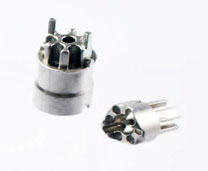MIM Design Principles
Component Size Range
MIM is applied to smaller components, and most of all parts are smaller than 25 mm or 1 inch in maximum dimension. Some larger sizes exist, but most are smaller. MIM is most competitive for components smaller components. On the other hand, MIM is widely used for small components, such as dental orthodontic brackets, where features are very small.
Most MIM components have thin wall sections. Thinner walls reduce mass and have faster molding cycle times. Ideal wall thickness is 2-3 mm (0.080 – 0.125″ inch) or less. MIM works best with uniform wall thicknesses. It is also thickness that dictates de-binding time, so thick sections are avoided or “cored out” when possible. An especially difficult situation is when thick and thin sections join. The difference in cooling and heating rates generates stresses that damage the component. During de-binding the thick section gives up binder first and is weak, while the thicker section induces a stress that can cause cracking. Thus, the typical ratio of maximum to minimum wall thickness is about 2 to 3. Other ranges are possible, but may require special fixtures during processing to help avoid distortion.
A minimum wall thickness of 0.5 mm/0.020″ for short sections is possible. Thicker wall sections are recommended to be a maximum of 3 mm/0.125″. Walls can be thicker but it diminishes the advantages of MIM, coring is highly recommended. Maximum lengths of 3″ in any direction are also recommended. Most parts are under 25 mm/1″.

